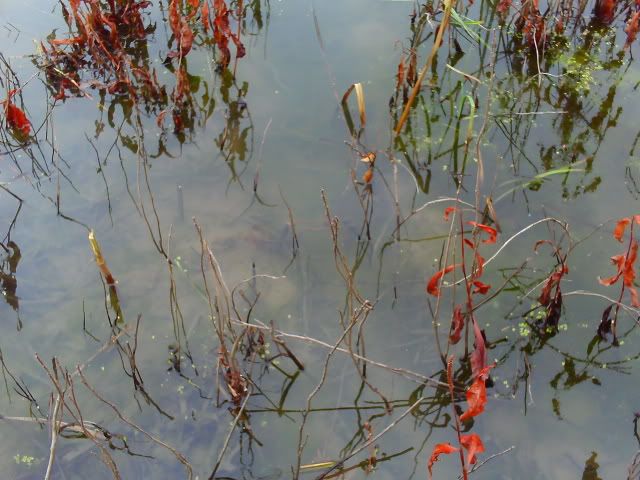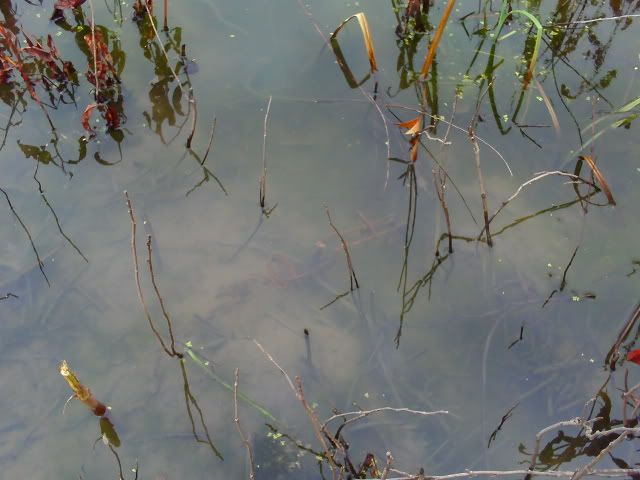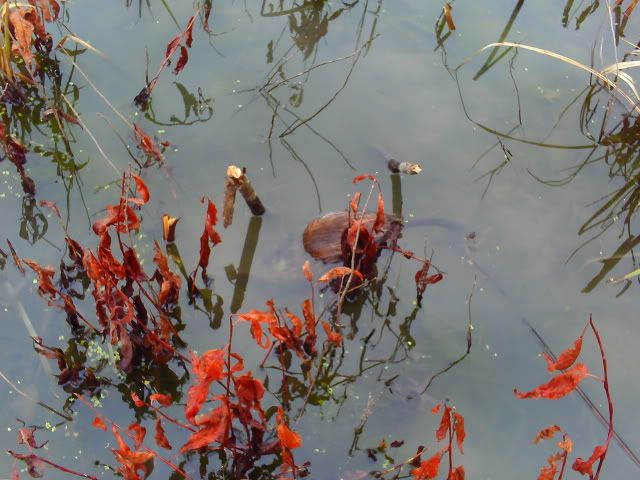|
 Muskrat Activity In Cattail Marsh Habitat
#1606816
Muskrat Activity In Cattail Marsh Habitat
#1606816
11/21/09 12:51 AM
11/21/09 12:51 AM
|
Joined: Dec 2006
Northwestern New York(Elder)
Jonathan
 OP
OP
"Wilson"
|
 OP
OP
"Wilson"
Joined: Dec 2006
Northwestern New York(Elder)
|
While out with my camera today I thought I would document some muskrat activity in a cattail marsh for my Trapping Library, and to share with those on the forum who may not be familiar with these structures. Winter muskrat houses, lodges or huts are built in the fall, and so are their feed beds or "push ups".They are often misread by new or beginning trappers as being one in the same. But they are completely different from each other. In this type of habitat, the living quarters are much larger than the feed beds and are made primarily from cattail plant stock. The huts in these examples are about 4-6 feet high and up to 8 feet in diameter. I have seen them much larger than these over the years in some Wisconsin marshes. 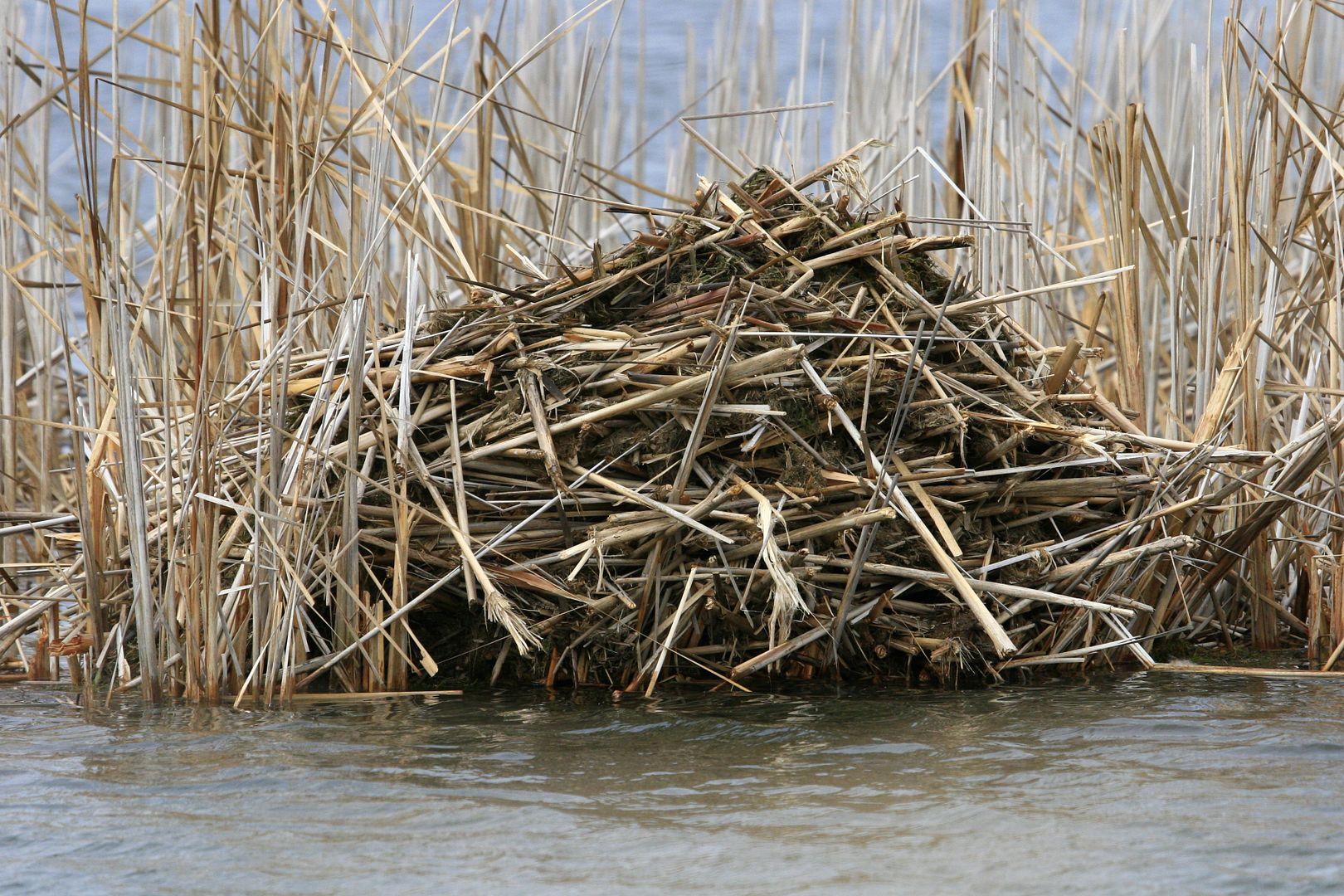 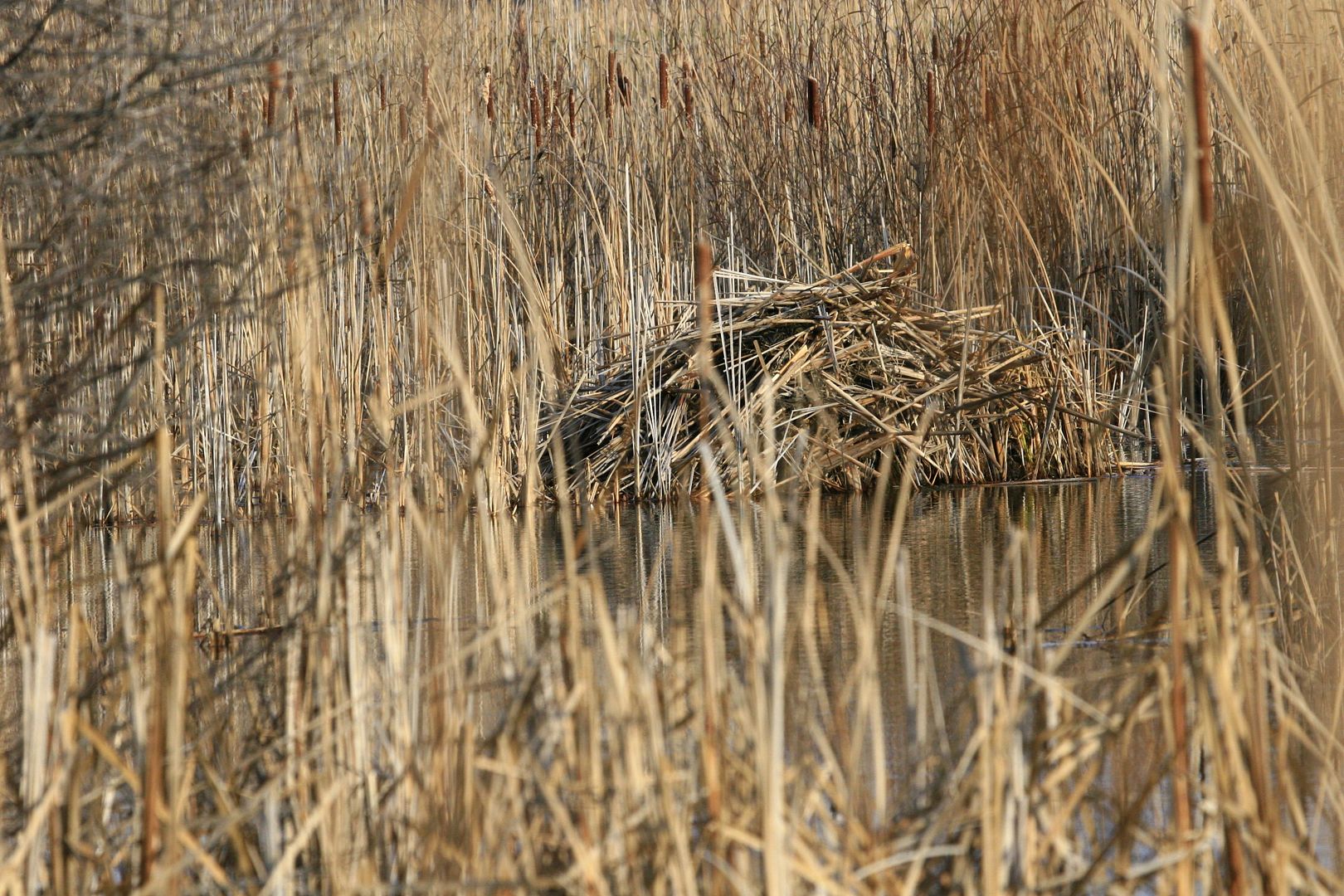 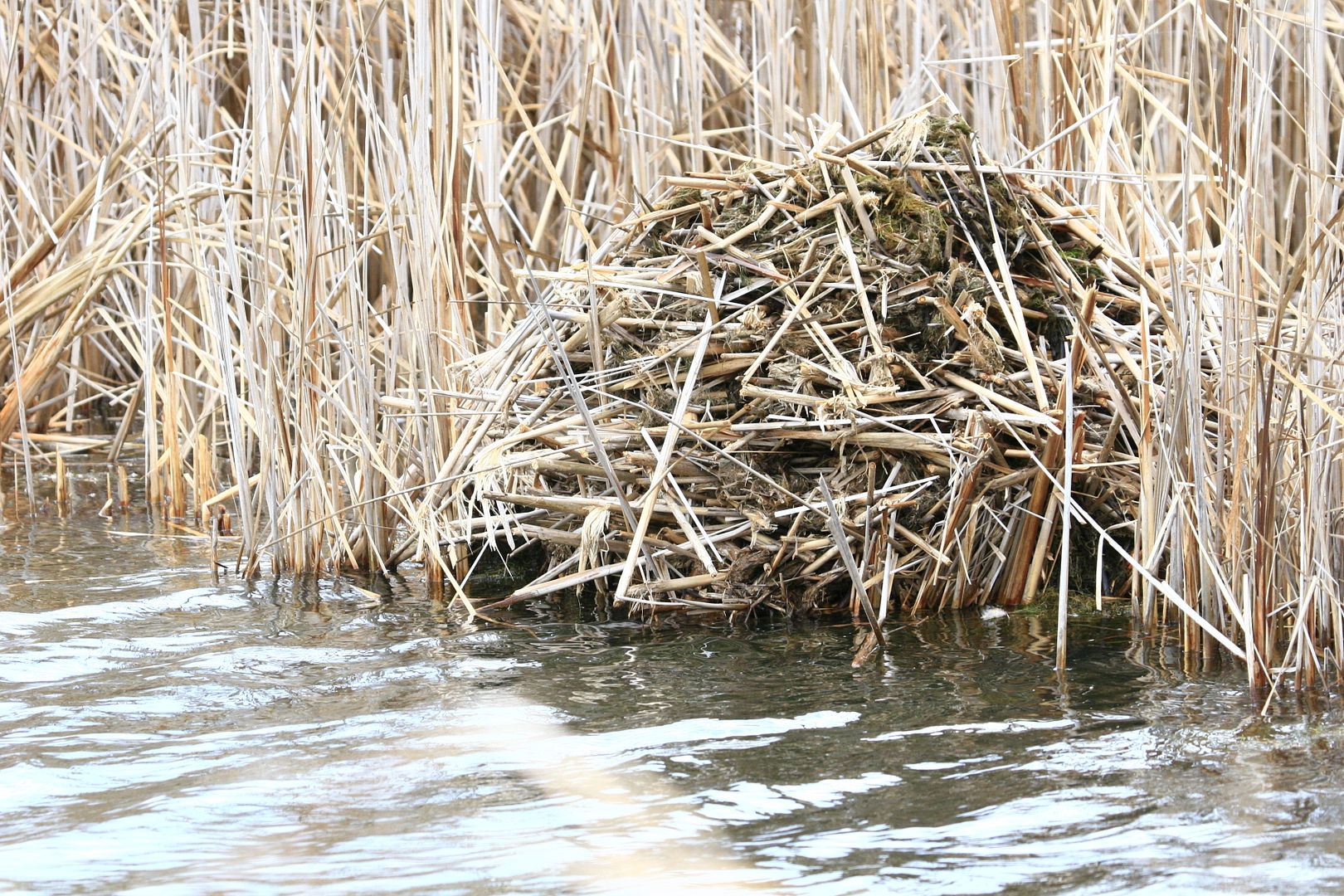 By contrast, the feed beds are significantly smaller and made up of finer vegetation - either from submergent aquatic vegetation, or from grasses and root stock sources on land adjacent to the water. From a distance in this case, you can tell that they are different, mainly by their size, color, shape and the materials they are comprised of. Those pictured in the open water area are about 3 feet in diameter and 2-3 feet high. 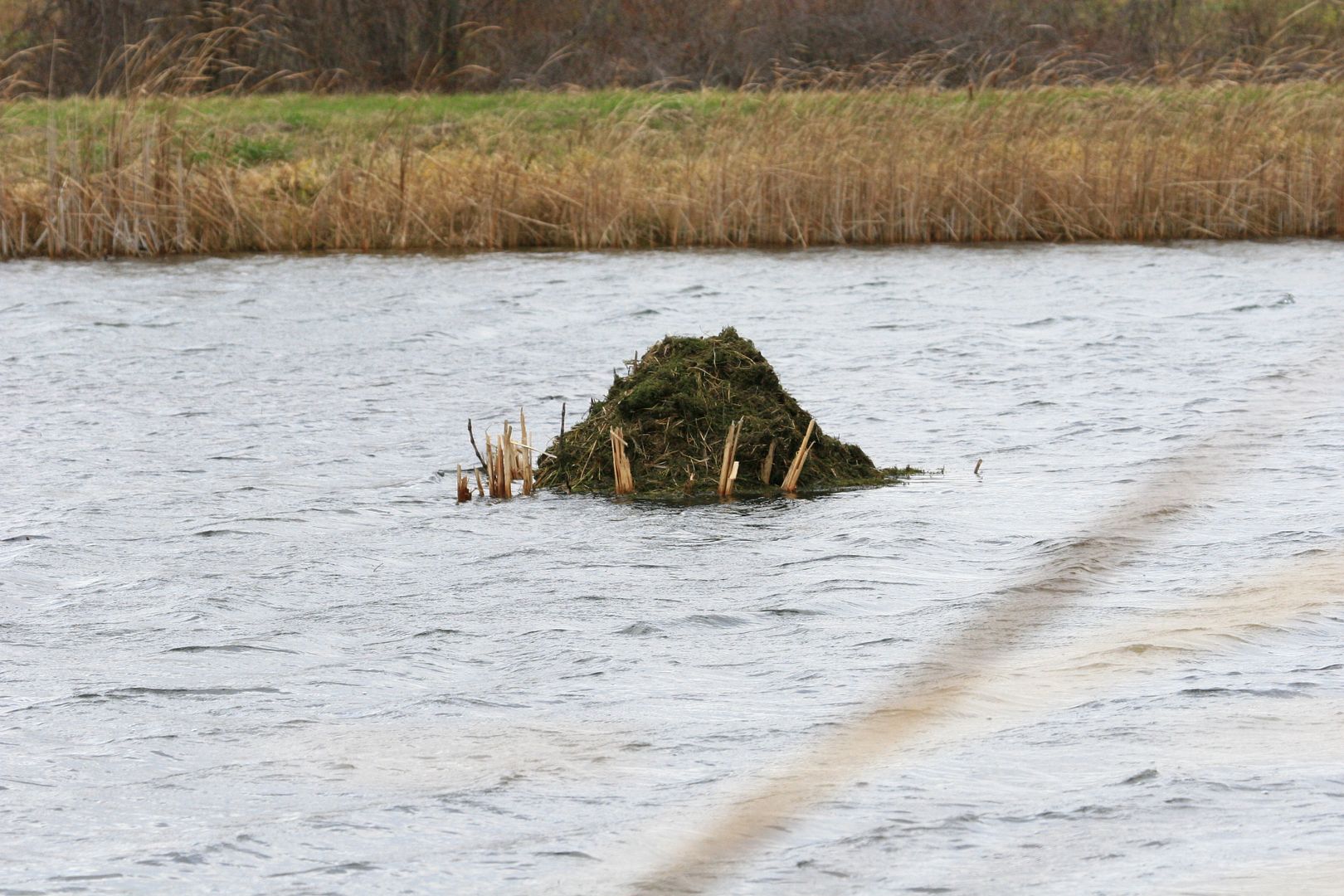   This is a smaller one adjacent to the shoreline and was actively under construction. It appeared to be almost finished. It was about 2 feet in diameter and about 18" high. 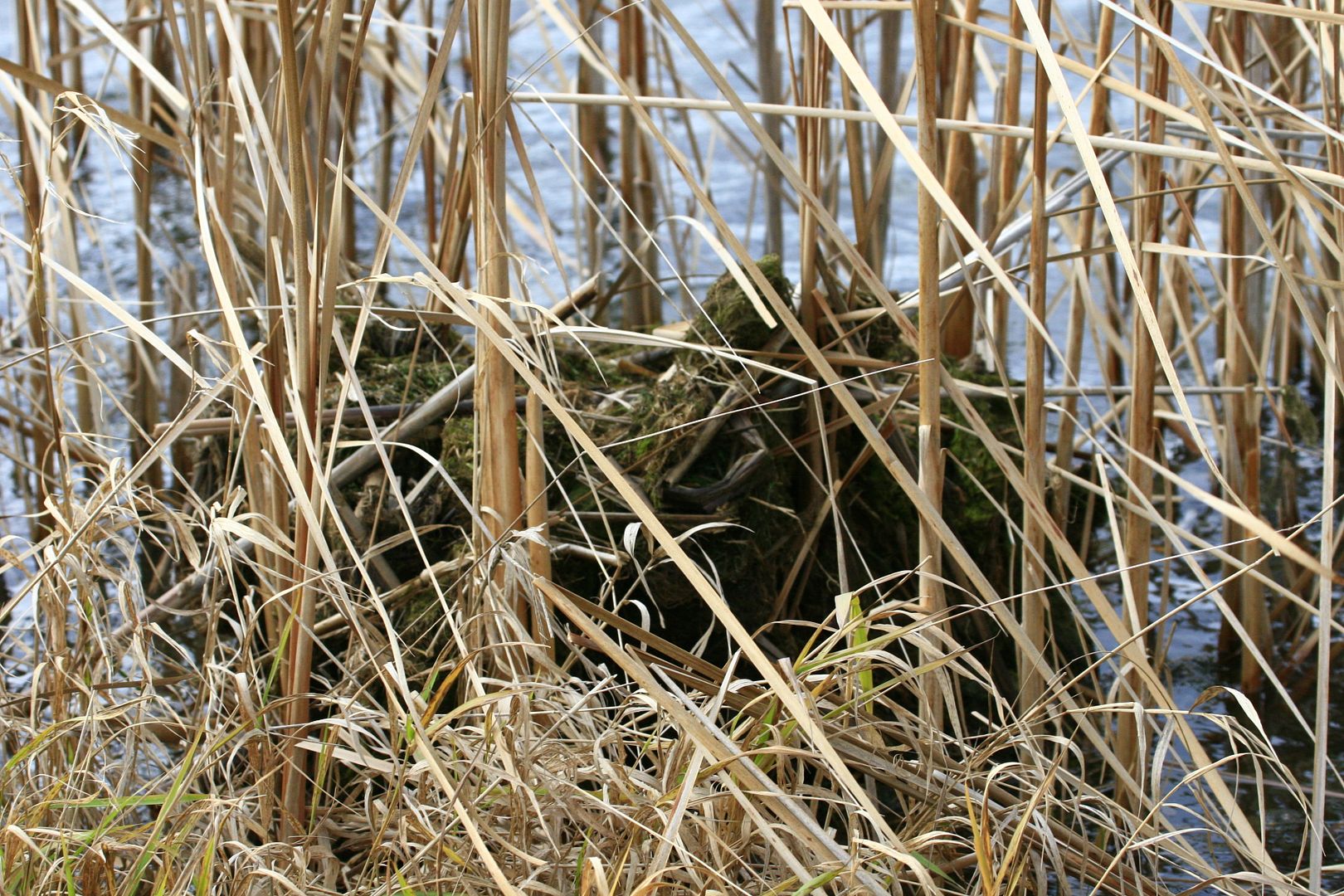 If you look close enough, you can see the finer green vegetation and fresh chewings from tubers and stems. 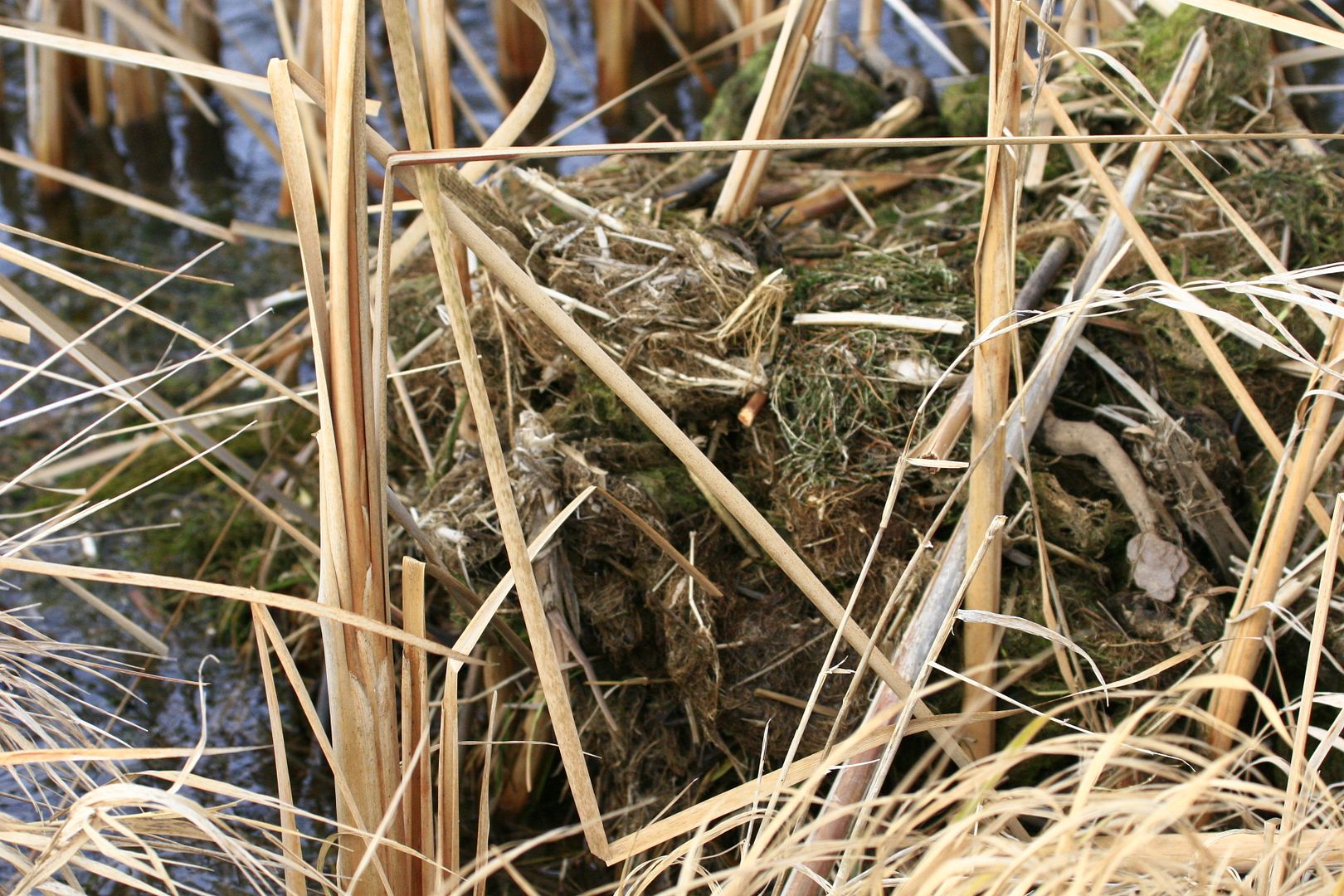 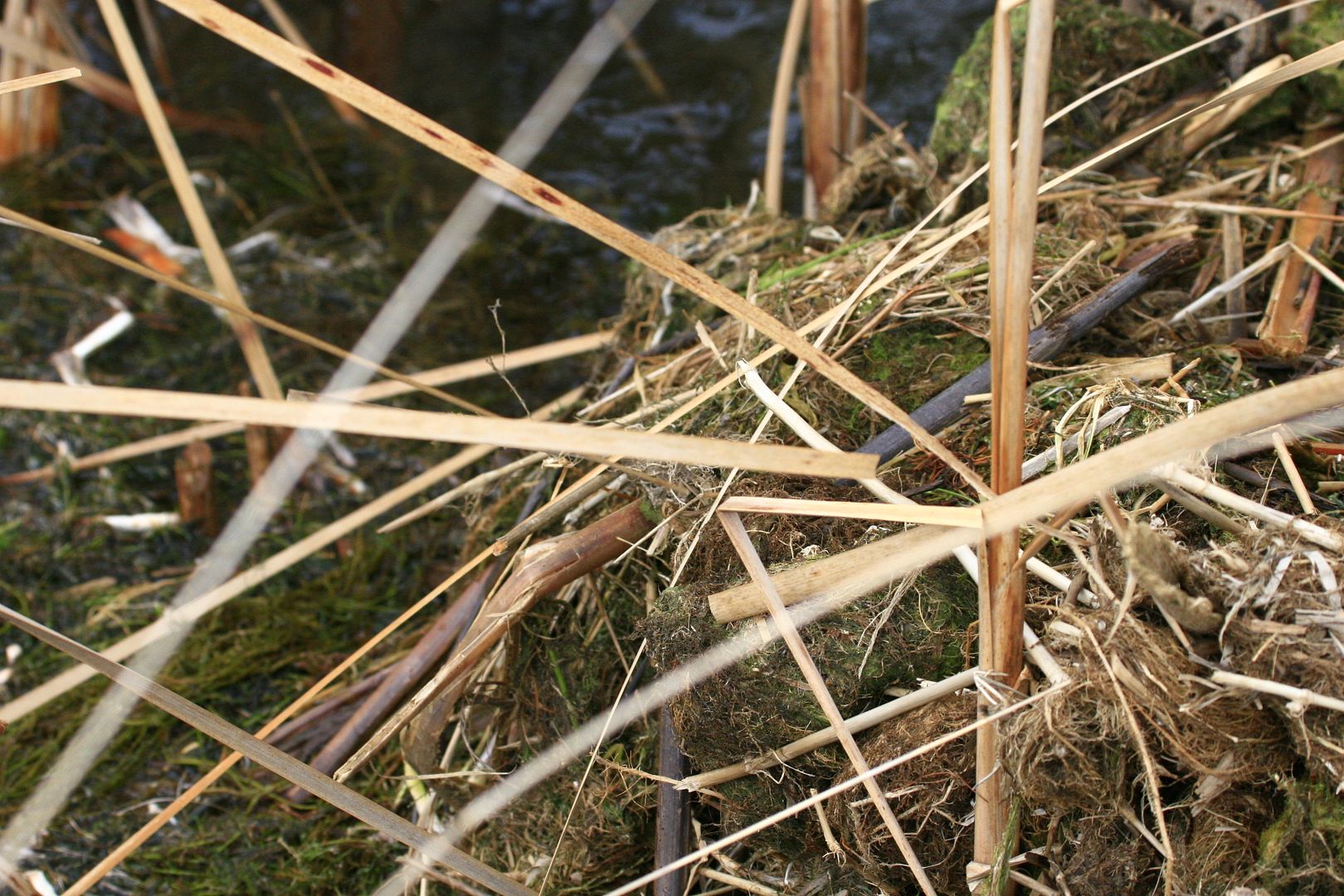 Thought this might be a little helpful showing muskrat sign in a cattail marsh and how to tell the difference between both activities prior to ice up to get them through the winter in this northern habitat type. Jonathan
Camera Gear: Canon EOS 7D-MK-II, Canon EF-S 10-22mm, EF 28-135mm, EF 100-400mm and EF 400mm lenses.
|
|
|
 Re: Muskrat Activity In Cattail Marsh Habitat
[Re: K9.Trapper]
#1606882
Re: Muskrat Activity In Cattail Marsh Habitat
[Re: K9.Trapper]
#1606882
11/21/09 02:12 AM
11/21/09 02:12 AM
|
Joined: Feb 2007
Higginsville Missouri
deerhunter65347

trapper
|

trapper
Joined: Feb 2007
Higginsville Missouri
|
Here in missouri in my parts we dont have a lot of cattails But we have small sloughs. Here is a hut made from the surrounding material. It has one entrance. 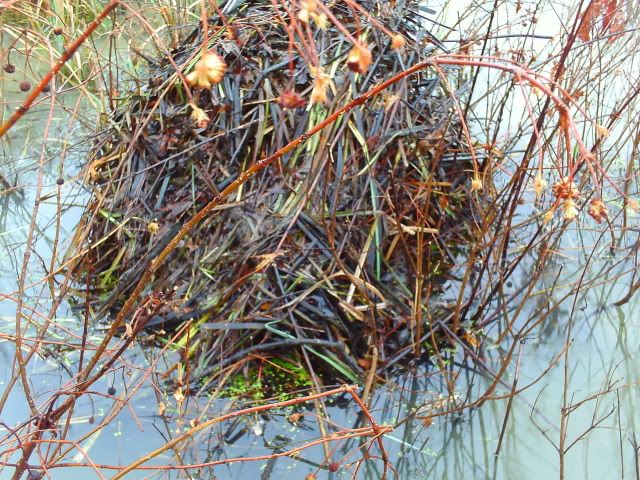 In the next picture you can see a feed bed in the distance its made from the smaller material and has no entrances. Its surrounded by clear water and they have the bottom cleaned all around it from all the activity. They grab moss and all types of small material and pile it high. 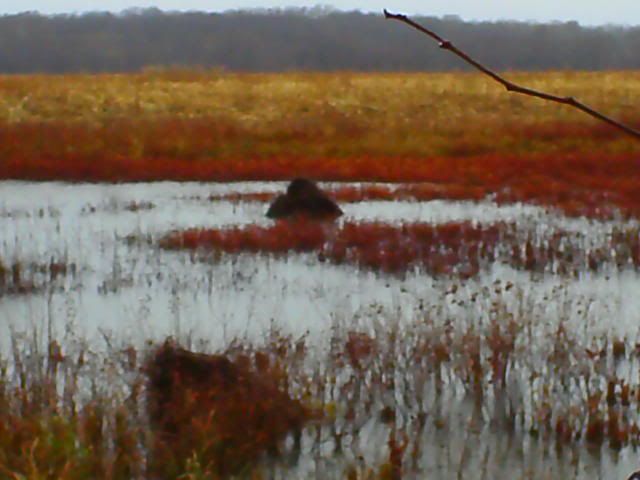 In the next pic you can see the hut next to the bank and the feed bed in the distance 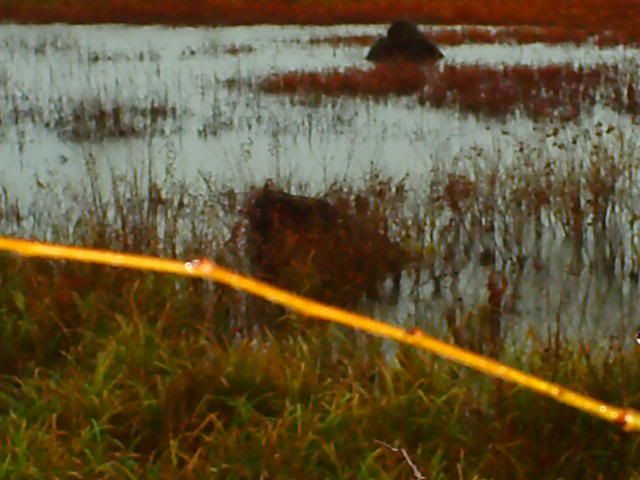 So even in our latitude the same principals apply. Thanks for all the info and great pics Jonathan
|
|
|
 Re: Muskrat Activity In Cattail Marsh Habitat
[Re: deerhunter65347]
#1606935
Re: Muskrat Activity In Cattail Marsh Habitat
[Re: deerhunter65347]
#1606935
11/21/09 03:44 AM
11/21/09 03:44 AM
|
Joined: Dec 2006
Northwestern New York(Elder)
Jonathan
 OP
OP
"Wilson"
|
 OP
OP
"Wilson"
Joined: Dec 2006
Northwestern New York(Elder)
|
Tony, I saw your post on this topic a few days ago, but thought your post's title (headline) would be lost. I was going to add to it, but thought the gist of intent would be missed by most. So.......I decided to introduce my northern view of their makeup. I couldn't relate to what your more southern structures were comprised of - they looked like feed beds to me up here without size descriptions, etc. I've been after these beauties since I was an 8 year old in 1950, a little longer than most, with possibly the exception of T-man member "Actor" (aka Garry). Jonathan 
Camera Gear: Canon EOS 7D-MK-II, Canon EF-S 10-22mm, EF 28-135mm, EF 100-400mm and EF 400mm lenses.
|
|
|
 Re: Muskrat Activity In Cattail Marsh Habitat
[Re: Jonathan]
#1606980
Re: Muskrat Activity In Cattail Marsh Habitat
[Re: Jonathan]
#1606980
11/21/09 06:15 AM
11/21/09 06:15 AM
|
Joined: Apr 2008
Michigan
Balex1873

trapper
|

trapper
Joined: Apr 2008
Michigan
|
Thanks for the posts guys, We just started targeting muskrats in the marsh this year. Up until now it's been all creek rats. The pics and descriptions are a big help.
Challenge your preconceptions or they will challenge you.
|
|
|
 Re: Muskrat Activity In Cattail Marsh Habitat
[Re: MnMan]
#1607241
Re: Muskrat Activity In Cattail Marsh Habitat
[Re: MnMan]
#1607241
11/21/09 12:19 PM
11/21/09 12:19 PM
|
Joined: Dec 2006
Northwestern New York(Elder)
Jonathan
 OP
OP
"Wilson"
|
 OP
OP
"Wilson"
Joined: Dec 2006
Northwestern New York(Elder)
|
Thank you for your kind words.
The small feed bed still under construction got my juices motivated. This afternoon I am going to set up a trail camera near it in an attempt to capture a few videos of the activity there.
Will also look for additional sign related to this habitat - closer views of the chewings and digging on land.
Jonathan
Camera Gear: Canon EOS 7D-MK-II, Canon EF-S 10-22mm, EF 28-135mm, EF 100-400mm and EF 400mm lenses.
|
|
|
 Re: Muskrat Activity In Cattail Marsh Habitat
[Re: Jonathan]
#1607261
Re: Muskrat Activity In Cattail Marsh Habitat
[Re: Jonathan]
#1607261
11/21/09 12:29 PM
11/21/09 12:29 PM
|
Joined: Dec 2006
Iowa
Oldtoolsniper

trapper
|

trapper
Joined: Dec 2006
Iowa
|
Nice write up and very nice photography
“Work hard! Millions on welfare depend on it!”
|
|
|
 Re: Muskrat Activity In Cattail Marsh Habitat
[Re: deerhunter65347]
#1607403
Re: Muskrat Activity In Cattail Marsh Habitat
[Re: deerhunter65347]
#1607403
11/21/09 02:17 PM
11/21/09 02:17 PM
|
Joined: Dec 2006
Northwestern New York(Elder)
Jonathan
 OP
OP
"Wilson"
|
 OP
OP
"Wilson"
Joined: Dec 2006
Northwestern New York(Elder)
|
Skunk, That is not uncommon in man-made ponds constructed with an impoundment type of dam, dike or berm. In many situations of this nature (lacking huts) the muskrats are living in bank dens, making only feed beds from the submergent and emergent aquatic vegetation in the pond.
In Ohio, if there were going to be huts on a pond in preparation for winter living quarters, they would have been built by now. Without huts and only feed beds/push ups, it is safe to assume the muskrats are using bank dens either in the pond proper, or in the ditch or small stream that may be an unobstructed inlet water source for the pond.
Muskrats are born engineers when it comes to housing and food storage to survive through a northern winter. They adapt accordingly in pond environments with an adequate food supply to hold them over.
Every pond is different, and it can be challenging at times to determine how and where to set traps for them - especially with fresh sign around. Once in awhile it takes a little time to figure that strategy out, but with keen observation and good techniques applied a decent harvest is possible.
Jonathan
Camera Gear: Canon EOS 7D-MK-II, Canon EF-S 10-22mm, EF 28-135mm, EF 100-400mm and EF 400mm lenses.
|
|
|
 Re: Muskrat Activity In Cattail Marsh Habitat
[Re: Trapset]
#1607425
Re: Muskrat Activity In Cattail Marsh Habitat
[Re: Trapset]
#1607425
11/21/09 02:46 PM
11/21/09 02:46 PM
|
Joined: Feb 2009
Kansas
Gage Drift

trapper
|

trapper
Joined: Feb 2009
Kansas
|
Did you ever finish the "tote and pack" project you were working on a while back? Thanks for another good thread Johnny!  I'd like to see your packbasket project too, as I've been working on a design. Please bring it on.
|
|
|
 Re: Muskrat Activity In Cattail Marsh Habitat
[Re: Gage Drift]
#1608385
Re: Muskrat Activity In Cattail Marsh Habitat
[Re: Gage Drift]
#1608385
11/22/09 12:22 AM
11/22/09 12:22 AM
|
Joined: Dec 2006
Northwestern New York(Elder)
Jonathan
 OP
OP
"Wilson"
|
 OP
OP
"Wilson"
Joined: Dec 2006
Northwestern New York(Elder)
|
For those who have asked about my earlier intentions regarding a narrative about "Packbaskets And Totes," it is almost past outline and approaching rough draft stage. I was hoping to have had a post drafted before this trapping season. But, my ink has been delayed with fresh incoming additions.
It may take a bit of time to present this notion from an unquiet mind to drop it here as the best that I can.
Jonathan
Camera Gear: Canon EOS 7D-MK-II, Canon EF-S 10-22mm, EF 28-135mm, EF 100-400mm and EF 400mm lenses.
|
|
|
 Re: Muskrat Activity In Cattail Marsh Habitat
[Re: RogerDoger]
#1610419
Re: Muskrat Activity In Cattail Marsh Habitat
[Re: RogerDoger]
#1610419
11/23/09 02:16 AM
11/23/09 02:16 AM
|
Joined: Dec 2006
Northwestern New York(Elder)
Jonathan
 OP
OP
"Wilson"
|
 OP
OP
"Wilson"
Joined: Dec 2006
Northwestern New York(Elder)
|
I spent the afternoon at the marsh yesterday to document this habitat in a little more detail for this discussion, and set up a trail camera near a feed bed actively under construction - shown in the last two photos above. That feeder was added to since when I first found it Friday morning. Had to put the waders on to photograph it in more detail to show what they haul into and on one. Overnight it gained about 8" in height and almost a foot more in diameter. Here is that one showing the variety of vegetation in its makeup. There is always a single leading edge to these that I am aware of. You can see the "landing pad" approach to this one in the lower left of this photo. A perfect location for a #1-1/2 long spring. Though the season doesn't open until Wednesday, I'll show you tomorrow how I would set the trap there.  Here are closer views of additional food resources deposited. 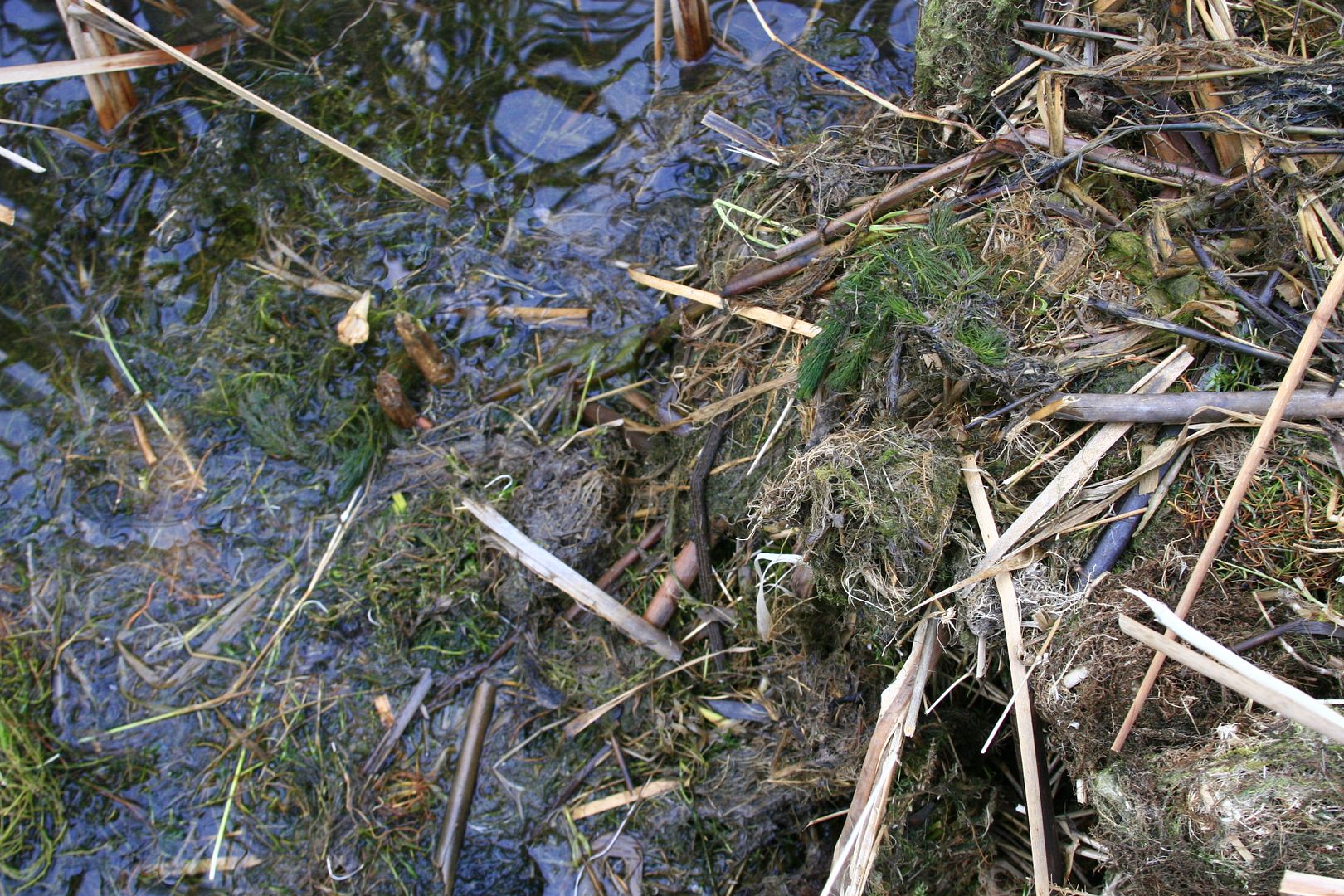 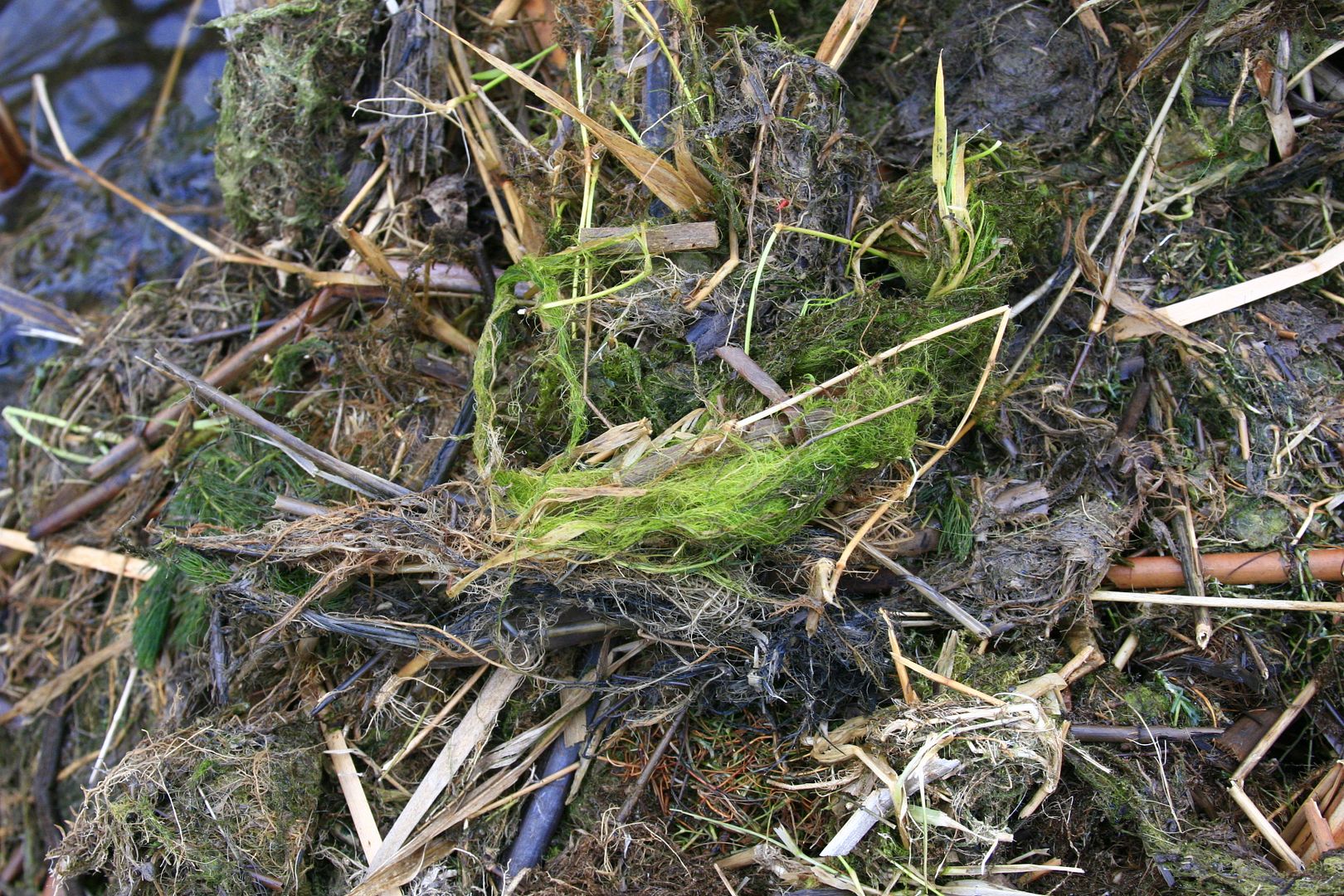 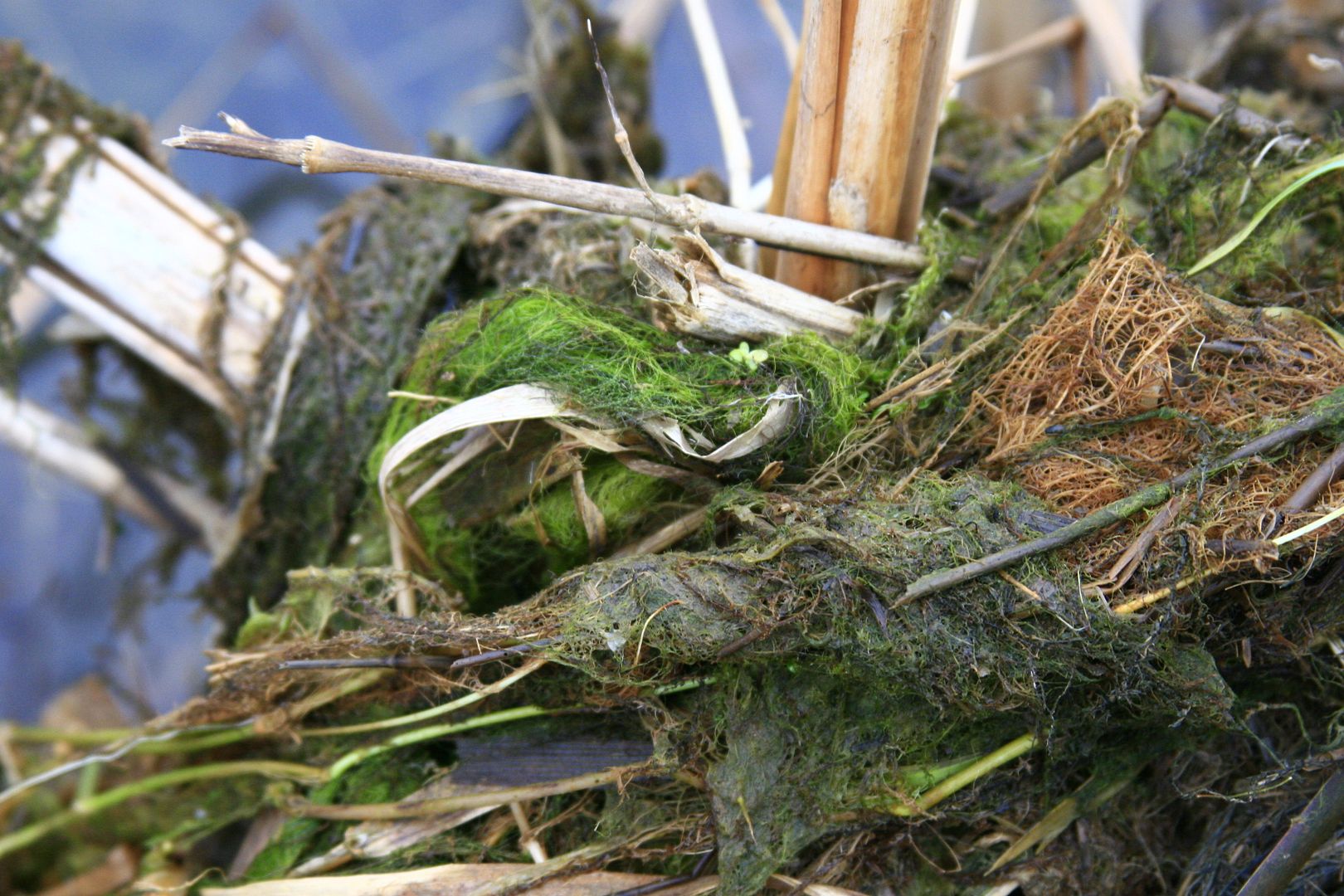 This one is completed and is about 50 yards north of the one above. Again, note the extended "landing" in the front and to the right on this one. 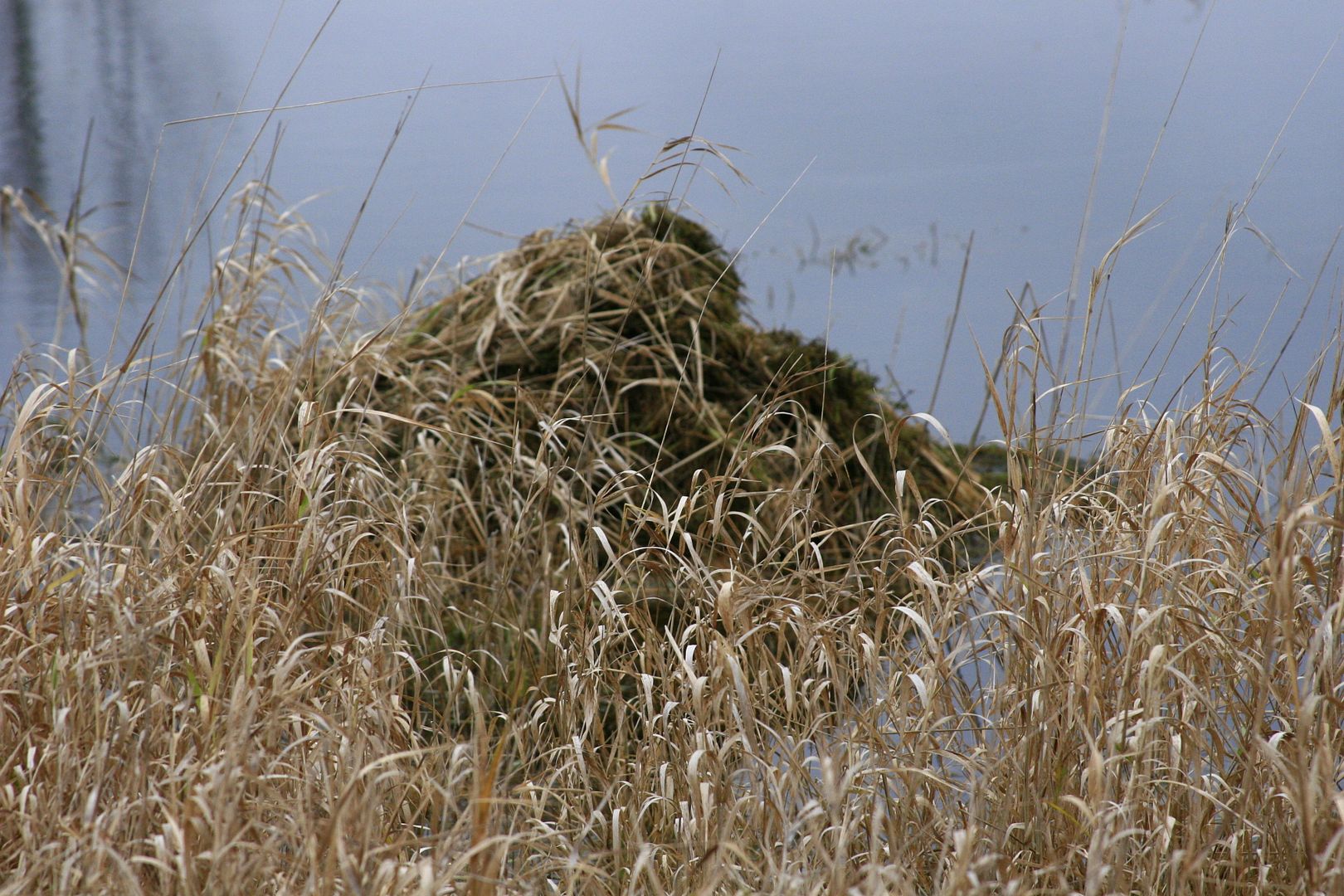 As mentioned before how they will often use grasses and their roots by digging on land, this sign was on land near this one. Note the trail coming from the water. These are not to be confused with old, caved in bank dens. There are no tunnels or borrows in these examples - just diggings for food items.  And examples of their signs of digging for material.   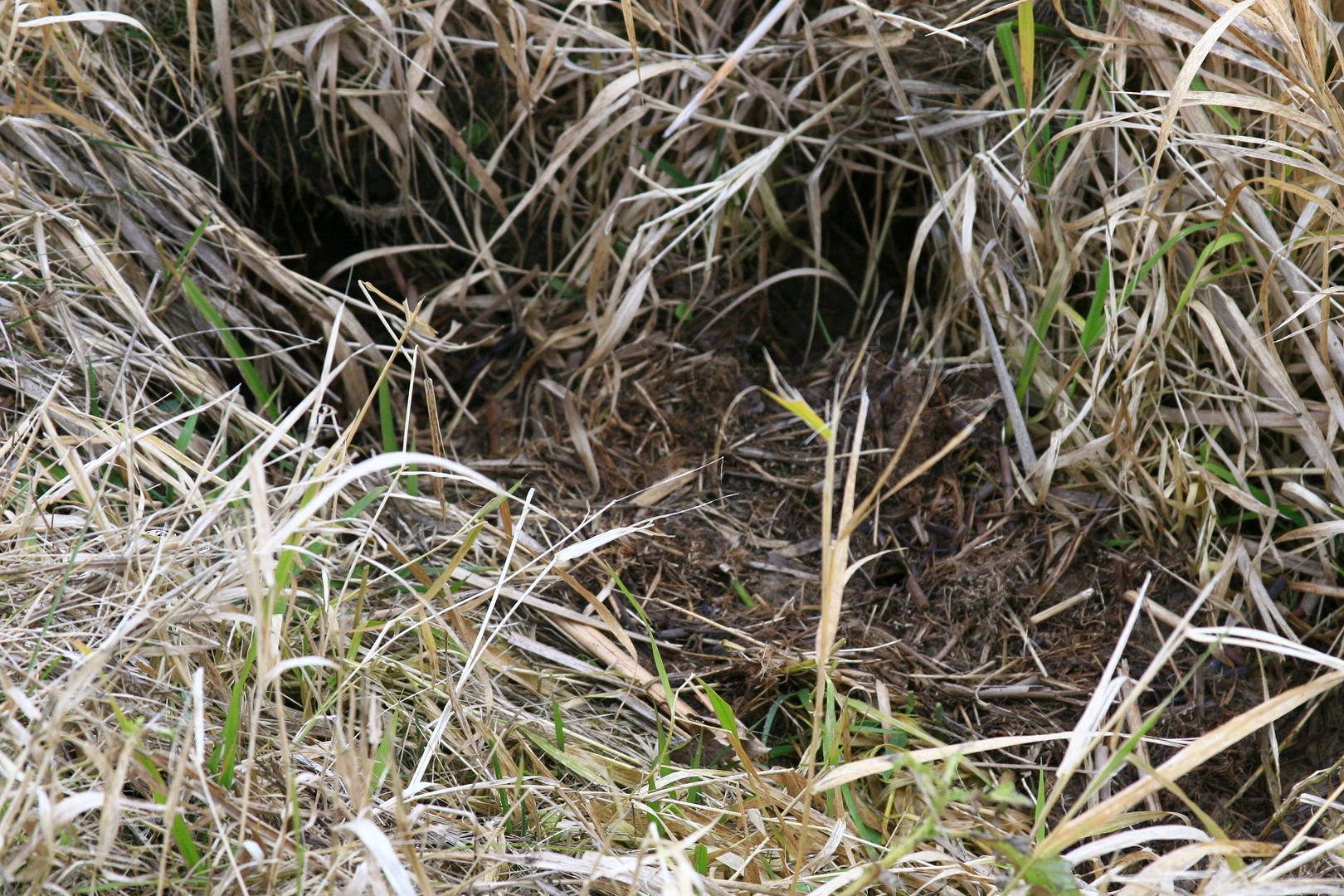 Here is another finished one in open water away from the shoreline unlike the previous two.  Not all muskrat droppings are like this most classic example of what they usually look like - almost separate individual pellets.  There size, shape, color and texture varies seasonally in different habitats, depending upon what they are eating at the time. In open marsh environments their droppings tend to be more on the mushy side in comparison and look more like these samples that I photographed Saturday at a typical muskrat "toilet" area. 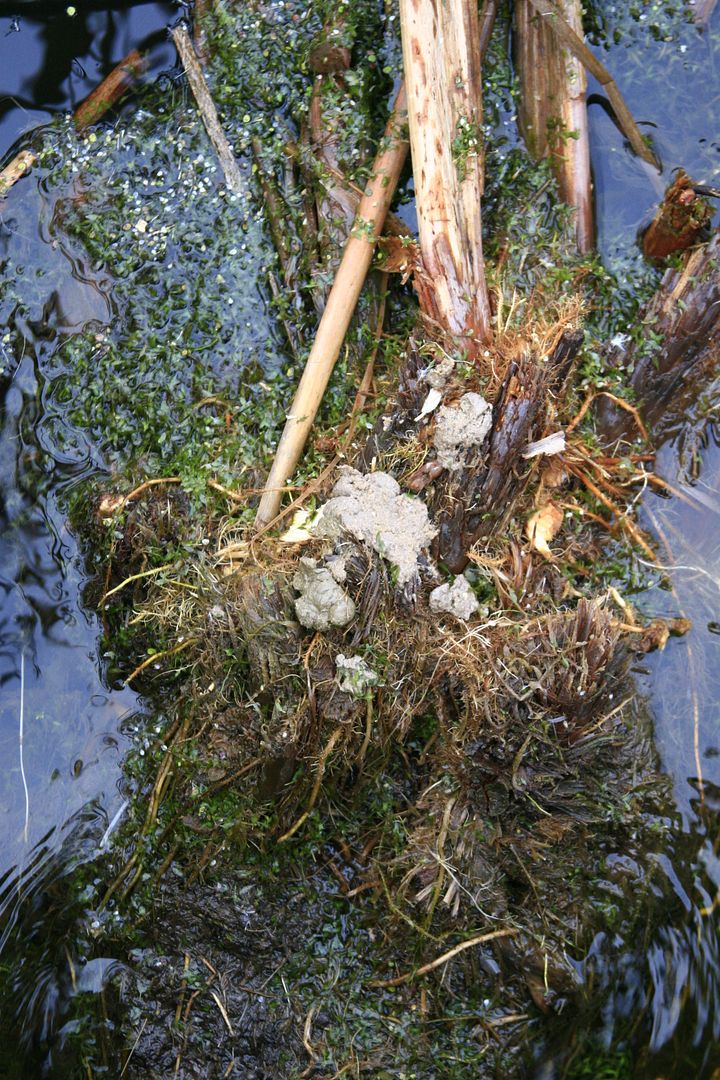  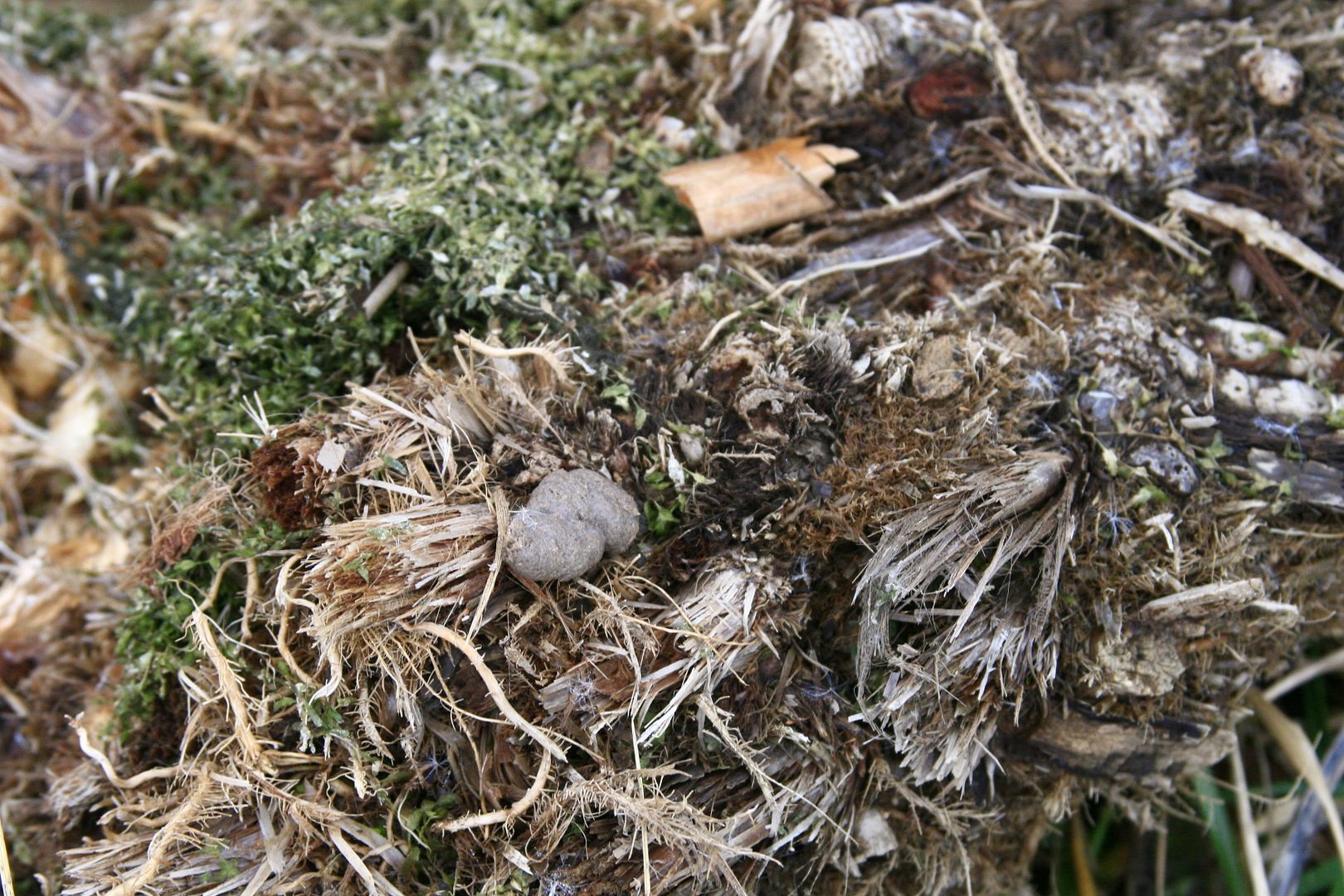 If you look closely at this blob you can see that the "pellets" are mushed together. There are 5 or 6 in this one. 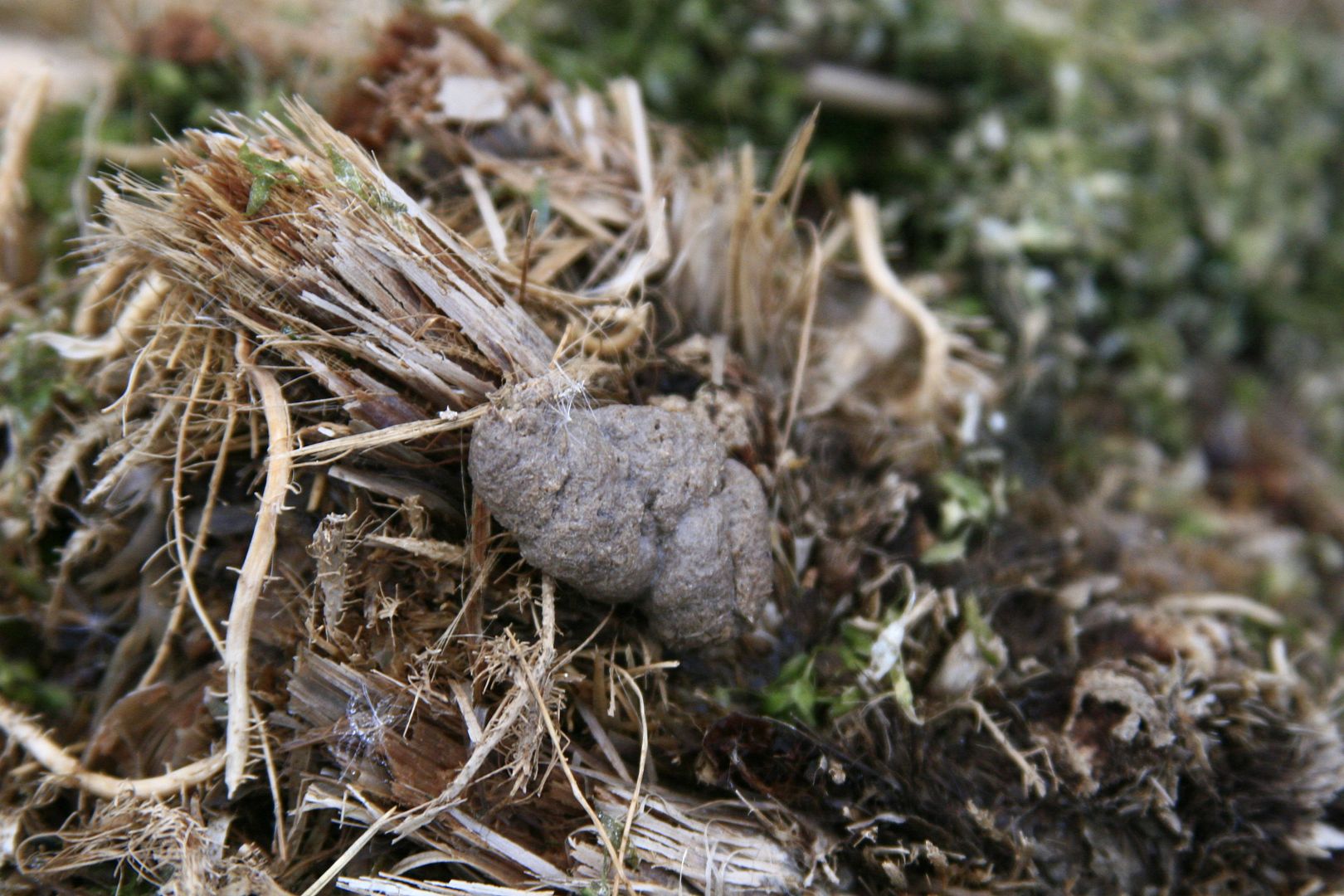 The light colored object to the left of this feed bed is my trail camera in the water tucked among the cattail stems. 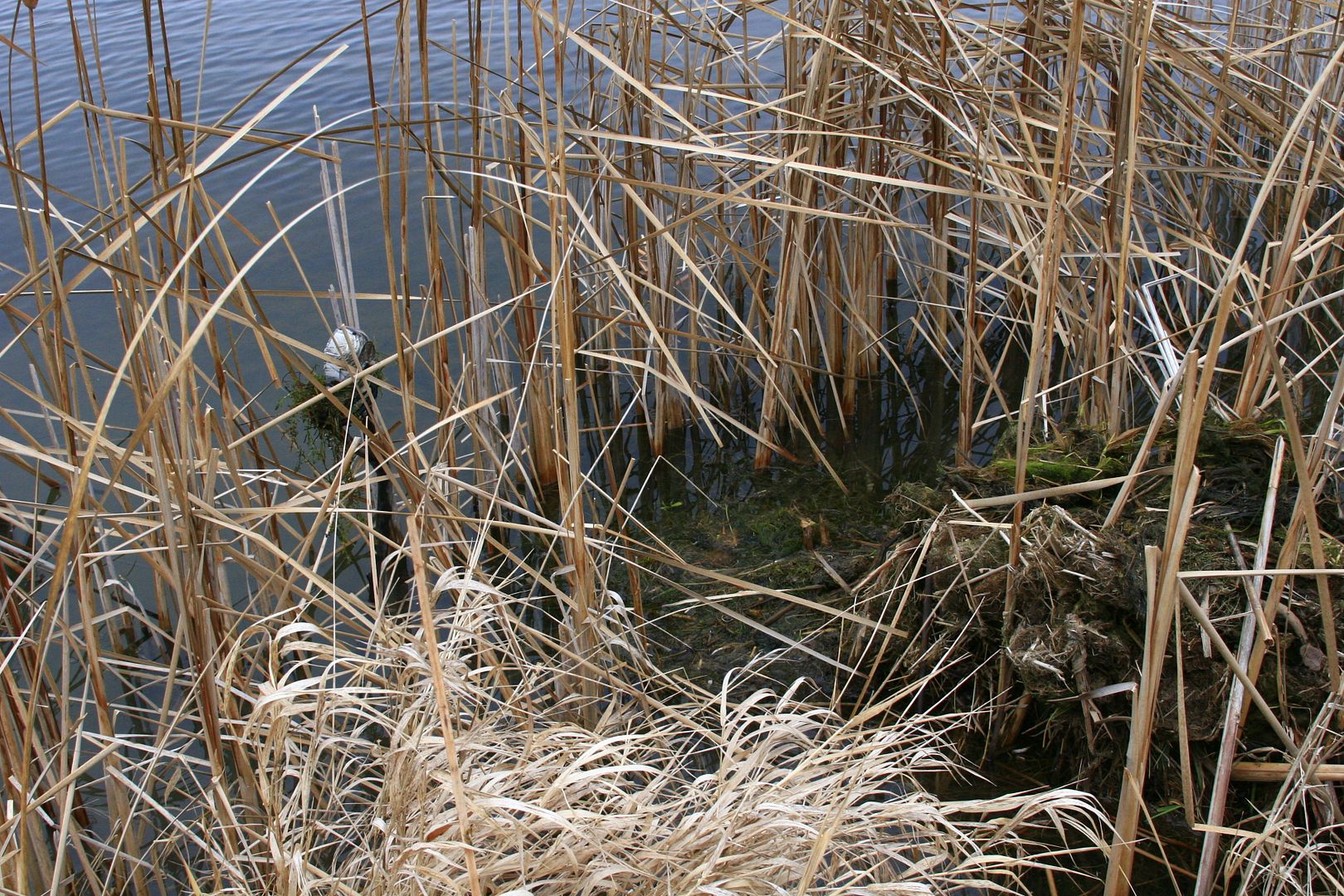 Closer views of how I mounted it in the crotch of my 4 foot long maple branch sling shot that I made at home before I poked it in the mud there. It is about 18" above the waterline and around 4 feet to the left of the feeder.  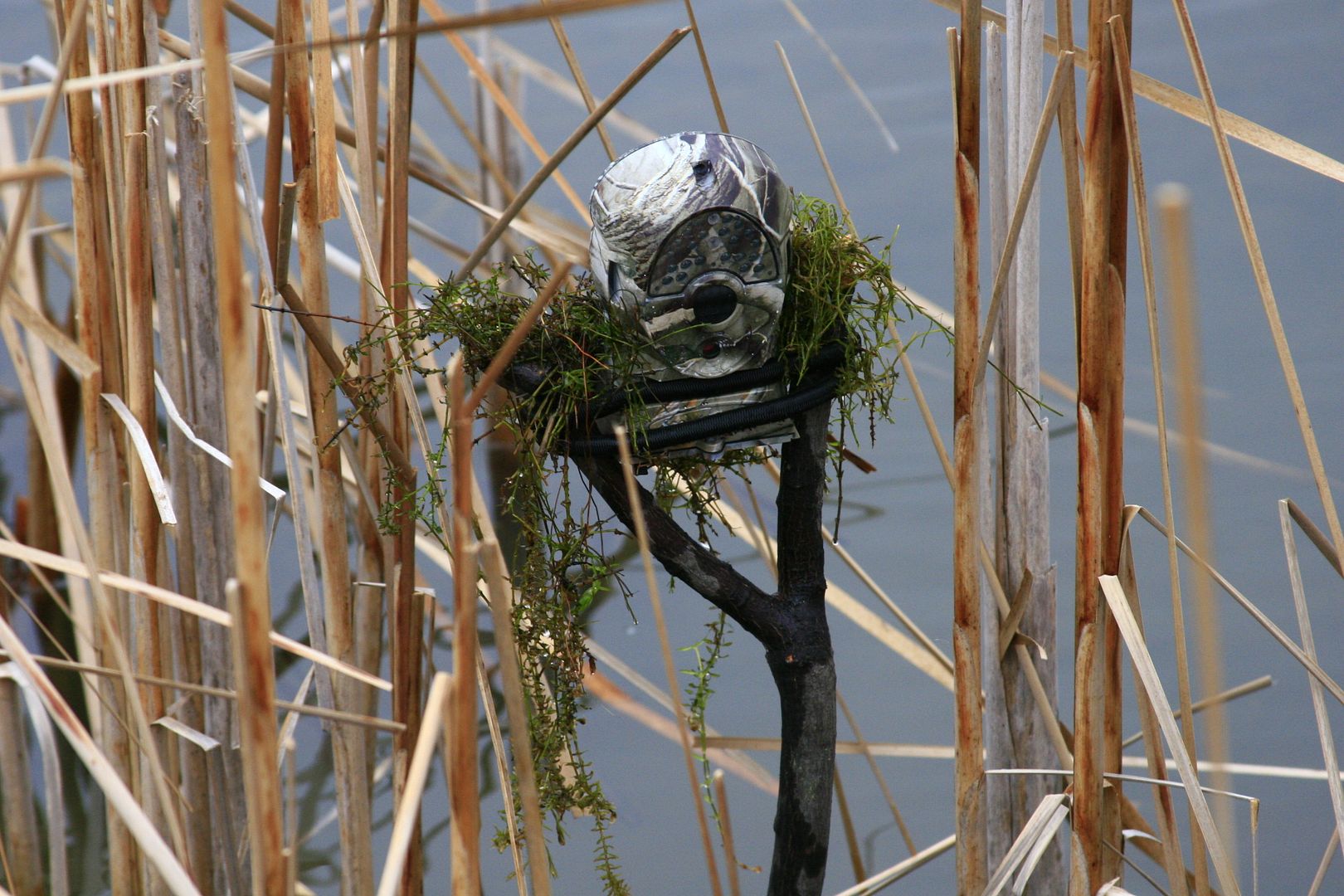 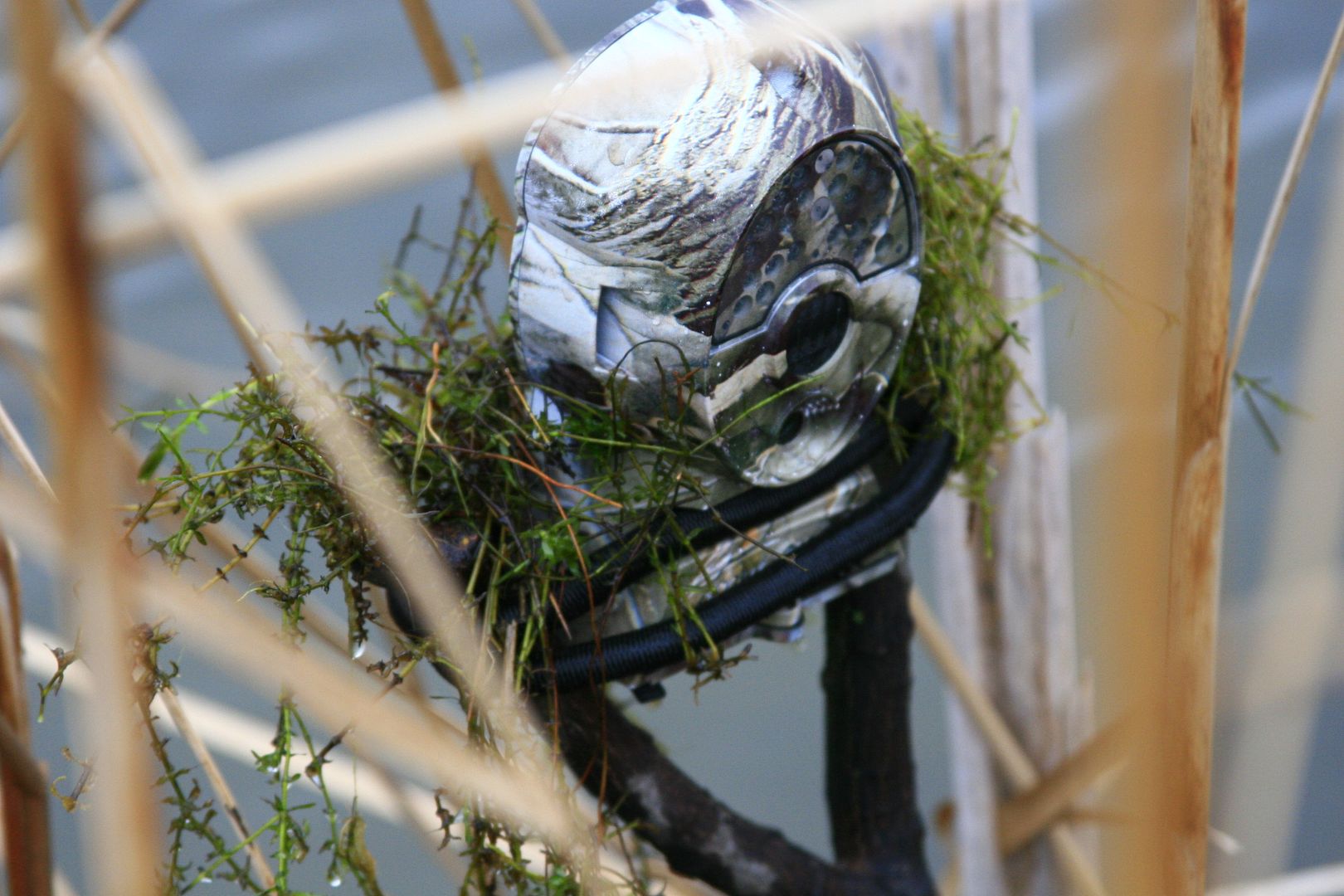 I have this set on a 60 second video mode. I am going to check it tomorrow. It will have been active for nearly three days and two full nights. If all goes well, the images should prove to be interesting, especially the time of day and their behavior during the construction process. As Deerhunter mentioned, these expansive marshes are tough to trap. 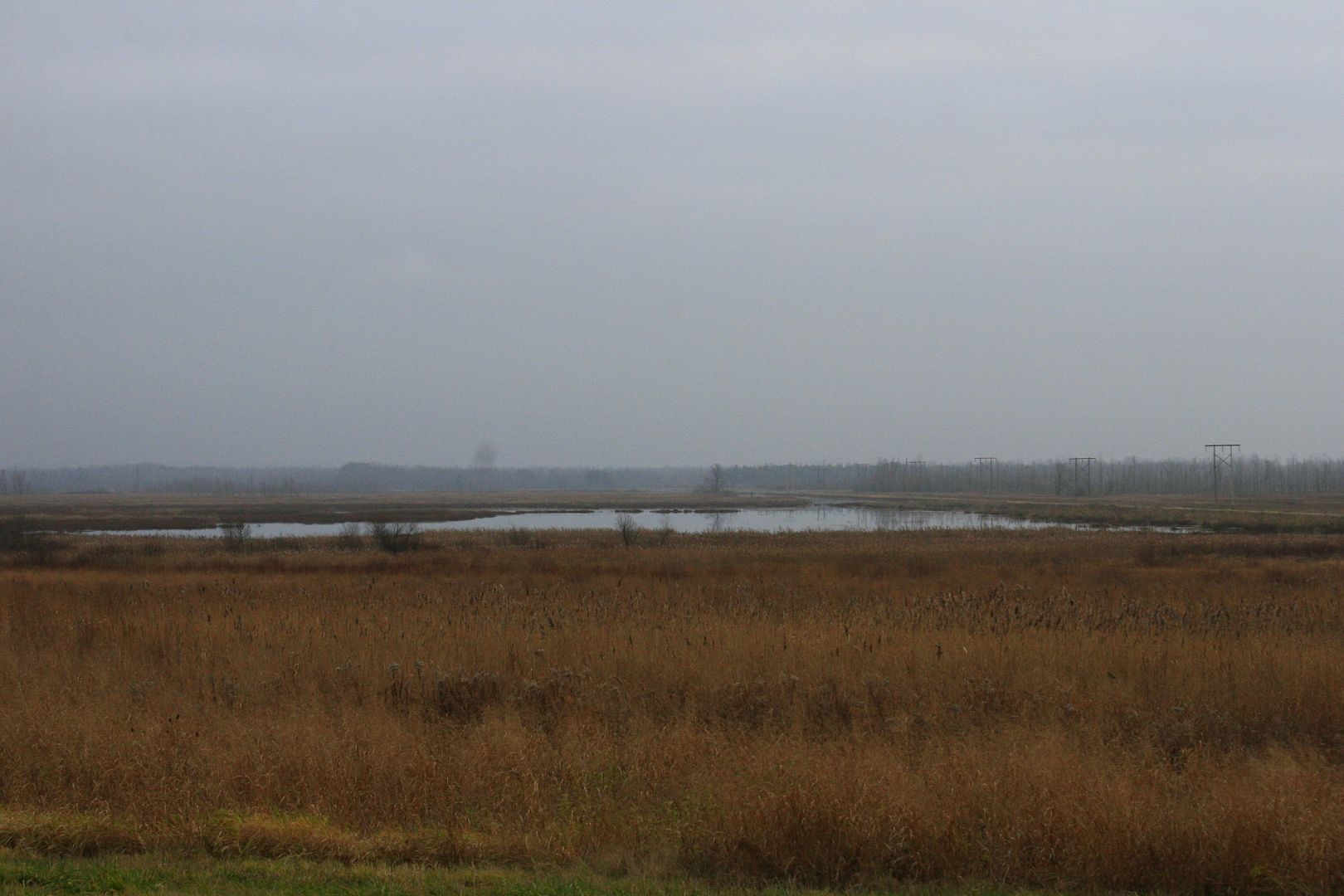 [img] http://i44.photobucket.com/albums/f2/Jonathan64/Muskrats/_MG_6997.jpg[/img] [img] http://i44.photobucket.com/albums/f2/Jonathan64/Muskrats/_MG_7000.jpg[/img] Access to them is often difficult and arduous. I did it for many years, working out of a duck skiff loaded with #1-1/2 long springs, a few #110's, bundles of willow stakes, a long handled canoe type paddle and an 8 foot long push pole with a duck bill on the end of it. It is a young man's sport. I couldn't do it physically now at my age, but my mind can. So....on that note, I am happy to share the memory and experience by telling younger trappers what muskrats tell us about themselves who live in marshes. I'll be back tomorrow, hopefully with a few more photos and videos in the share. Nite all! Jonathan
Camera Gear: Canon EOS 7D-MK-II, Canon EF-S 10-22mm, EF 28-135mm, EF 100-400mm and EF 400mm lenses.
|
|
|
 Re: Muskrat Activity In Cattail Marsh Habitat
[Re: Jonathan]
#1610668
Re: Muskrat Activity In Cattail Marsh Habitat
[Re: Jonathan]
#1610668
11/23/09 10:37 AM
11/23/09 10:37 AM
|
Joined: Jan 2007
backwoods N. Wi.
Fox Claw

trapper
|

trapper
Joined: Jan 2007
backwoods N. Wi.
|
Closer views of how I mounted it in the crotch of my 4 foot long maple branch sling shot that I made at home before I poked it in the mud there. It is about 18" above the waterline and around 4 feet to the left of the feeder. I'd like to see those pics, but I sincerely hope there is not an odd beaver or two swimming around that marsh. Next time consider using a metal post.
|
|
|
 Re: Muskrat Activity In Cattail Marsh Habitat
[Re: Fox Claw]
#1610720
Re: Muskrat Activity In Cattail Marsh Habitat
[Re: Fox Claw]
#1610720
11/23/09 11:19 AM
11/23/09 11:19 AM
|
Joined: Dec 2006
Wisconsin
Muskrat

trapper
|

trapper
Joined: Dec 2006
Wisconsin
|
It is a young man's sport. I couldn't do it physically now at my ageGreat pics, but . . . . young man's sport??? C'mon, pushing through those cattails, that's what builds character!!! 
Lifetime member of WTA and NTA
|
|
|
 Re: Muskrat Activity In Cattail Marsh Habitat
[Re: Weasel_Trapper]
#1614906
Re: Muskrat Activity In Cattail Marsh Habitat
[Re: Weasel_Trapper]
#1614906
11/25/09 03:24 AM
11/25/09 03:24 AM
|
Joined: Dec 2006
Northwestern New York(Elder)
Jonathan
 OP
OP
"Wilson"
|
 OP
OP
"Wilson"
Joined: Dec 2006
Northwestern New York(Elder)
|
Weasel Trapper, Yes I do. It is on my list of things to do. Thank you for the reminder. The best laid plans of mice and men do not always work out as intended. My attempt to capture this anticipated show and tell with that camera set up as shown for over two full nights and almost three days ended in total disappointment. When I found that individual feed bed it was actively under construction, but with little that I know about how muskrats build these winter stashes, I assumed too much. However, I had a gut feeling I may have been a little late for this one. Others that I saw that were similar in size and composition next to the shoreline were completed already - no current, fresh deposit activity on them that I could detect. I am not sure how these aquatic engineers decide how when enough is enough to quit making one of these where they decide to build one. I think it might be related to the amount of vegetation available within an immediate range of their swimming circle and time spent underwater needed to find and dig this stuff up. At first I thought the camera may have been placed too close to the point of aim. That was not the reveal when I moved in front of it yesterday, on purpose, to set the camera off to show how I would set a #1-1/2 long spring trap on the approach platform. That was the only video that I got from there over that time. When I came home and downloaded that SD card, I was bummed out. Nothing on the camera reveal except for my trap setting thingy. And, so it goes. I spent almost two hours at that location yesterday looking for a fresh start-up feed bed to set the camera up at. Nothing to be found anywhere. Oh, poop! Between the number of huts and feed beds observed at this location, I kinda concluded that there was probably not more than about 15 muskrats getting ready for winter there, and they were finished with the preparations to survive that spell in their life cycle until open water invited breeding for the next round of offspring to eventually take up space there to fill the void of family members who may have not been able to show up next time for various reasons - old age, disease and mink predation are in that formula. And, of course, otter, hawks and owls might have been on stage in the choreography of that life cycle's menu. I'll be ahead of the game next year if I am still vertical and above ground myself. Ha! Anyway, here is a still photo of how I would have set the #1-1/2 long spring at the landing on this feed bed during trapping season. Punch a dimple in it either with your boot or hand so the trap pan is about an inch underwater. Look close at these two photos to see where the trap pan is. You'll have to go back to this feed bed's photos shown earlier above to extrapolate my trap placement orientation. Jonathan 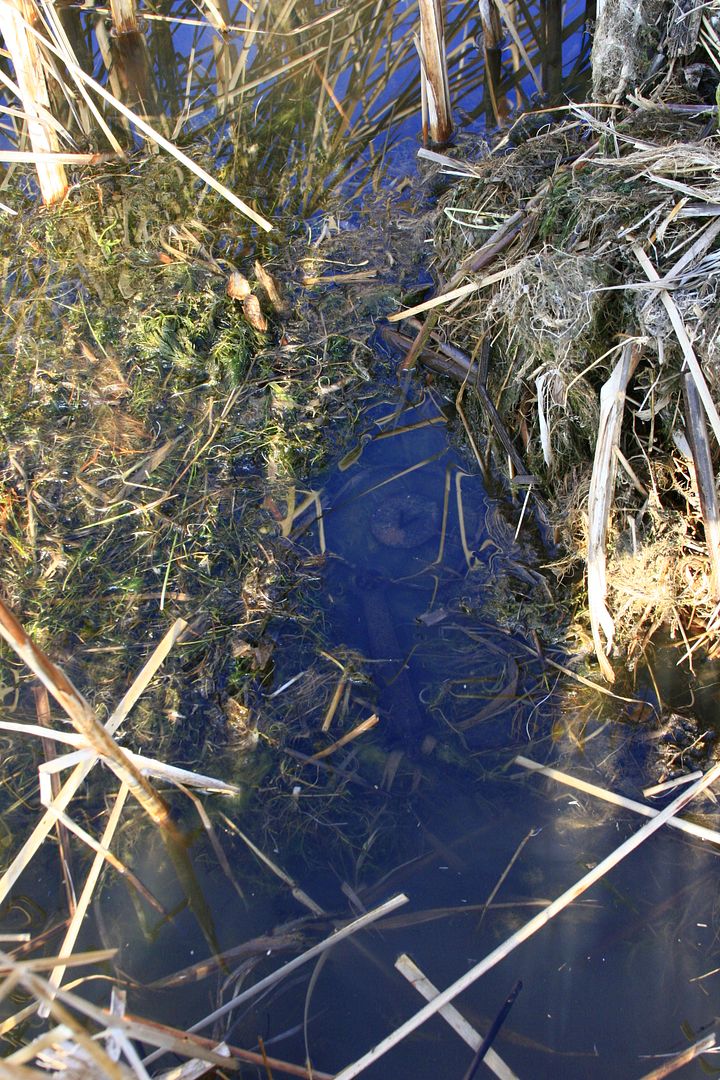 
Camera Gear: Canon EOS 7D-MK-II, Canon EF-S 10-22mm, EF 28-135mm, EF 100-400mm and EF 400mm lenses.
|
|
|
 Re: Muskrat Activity In Cattail Marsh Habitat
[Re: 2020]
#1615271
Re: Muskrat Activity In Cattail Marsh Habitat
[Re: 2020]
#1615271
11/25/09 11:21 AM
11/25/09 11:21 AM
|
Joined: Dec 2006
Wisconsin
Muskrat

trapper
|

trapper
Joined: Dec 2006
Wisconsin
|
Jonathan--Excellent pictorial essay. I prefer the stoploss over the longspring, but they both get the job done with sufficient drowning water.
2020--Just a quick question regarding the feed huts, I can't find any entrances going into them, so do the Rats wait for Freeze up and then chew in from under the Ice??
Quite often, from my experience, they will. Another thing to look for are "subways" to these feeder huts. If you've got shallow water, say two feet or less, the 'rats may be entering these feeder huts from underbottom tunnels, especially if the main 'rat hut is nearby.
I have all the right set ups but no clients showing up-I thought I was looking at a big House but it now seems to me that they are just feeder mounds,
It's easy to overestimate the number of 'rats in a marsh. Often feeder huts are confused with the main hut. Usually, from my experience here in Wisconsin, there's a ratio of 2-3 feeder huts per main hut.
You may even have bank denners with feeder huts out in the marsh.
Look for the active runs in the morning hours. They should show themselves with a slight cloudiness in the water due to recent activity. Also look for the fresh, green vegetation added to the sides, as Jonathan has so very well shown in the preceding pics.
Lifetime member of WTA and NTA
|
|
|
 Re: Muskrat Activity In Cattail Marsh Habitat
[Re: Muskrat]
#1615500
Re: Muskrat Activity In Cattail Marsh Habitat
[Re: Muskrat]
#1615500
11/25/09 01:15 PM
11/25/09 01:15 PM
|
Maineman27
Unregistered
|
Maineman27
Unregistered
|
|
|
|
 Re: Muskrat Activity In Cattail Marsh Habitat
[Re: jsaxton]
#1618537
Re: Muskrat Activity In Cattail Marsh Habitat
[Re: jsaxton]
#1618537
11/26/09 10:42 PM
11/26/09 10:42 PM
|
Joined: Dec 2006
Northwestern New York(Elder)
Jonathan
 OP
OP
"Wilson"
|
 OP
OP
"Wilson"
Joined: Dec 2006
Northwestern New York(Elder)
|
Thank you for the kind words.
From my experience and observations the feeders are made for winter use, and after ice up, muskrats tunnel under and into them to access the stash.
I believe the severity of the winter, the muskrat population densities in the individual huts using this food resource and the availability of submergent vegetation within their underwater swimming range to harvest food on the bottom (how long they can hold their breath to graze and return to the lodge) besides using the reserve feed beds, all factor into the frequency and need as to when these stashes are used.
Some winters they tunnel under them all; during others they may access and use only half of them that way. There are a lot of unsolved mysteries associated with muskrat behavior during any given year of a population's life cycle and requirements for overwinter survival.
Jonathan
Camera Gear: Canon EOS 7D-MK-II, Canon EF-S 10-22mm, EF 28-135mm, EF 100-400mm and EF 400mm lenses.
|
|
|
 Re: Muskrat Activity In Cattail Marsh Habitat
[Re: Martin]
#1618616
Re: Muskrat Activity In Cattail Marsh Habitat
[Re: Martin]
#1618616
11/26/09 11:13 PM
11/26/09 11:13 PM
|
Joined: Dec 2006
Northwestern New York(Elder)
Jonathan
 OP
OP
"Wilson"
|
 OP
OP
"Wilson"
Joined: Dec 2006
Northwestern New York(Elder)
|
Tony, Thank you for that valuable contribution illustrating the grass roots foraging that I referenced earlier. Your graphic is a far more dramatic and compelling example of this activity than mine revealed.
Neat!
Jonathan
Camera Gear: Canon EOS 7D-MK-II, Canon EF-S 10-22mm, EF 28-135mm, EF 100-400mm and EF 400mm lenses.
|
|
|
|
|














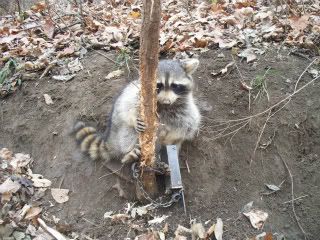

![[Linked Image]](https://i.ibb.co/r3ZWXpZ/traprenew.jpg)

